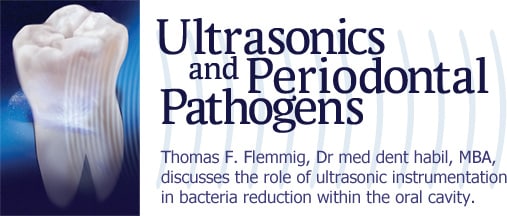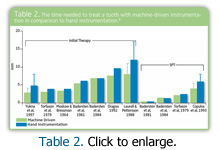
Ultrasonics and Periodontal Pathogens
Thomas F. Flemmig, Dr med dent habil, MBA, discusses the role of ultrasonic instrumentation in bacteria reduction within the oral cavity.
Q. Can periodontal pathogens be eliminated with ultrasonic instrumentation?
A. Completely eradicating oral pathogens from the oral cavity, at this point, is not possible. Sonic or ultrasonic scaling is designed for mechanical disruption of the biofilm and the flushing out of bacteria.
The main issue is whether we can eradicate or eliminate the pathogens at all. Research shows that with the exception of Aggregatibacter actinomycetemcomitans, which is found most frequently in localized aggressive periodontitis, predictable eradication of oral pathogens from the oral cavity doesn’t appear to be possible.1
Q. Does cavitation have a profound effect on pathogens?
A.Cavitation, produced by sonic or ultrasonic scalers, is not sufficient to actually kill bacteria. An article was published in 2000 by Schenk et al2 that looked at a number of pathogens and exposed them to magnetostrictive ultrasonic scalers, sonic scalers, and an ultrasonic cell disruptor (used in laboratories to break up bacterial cells). Periodontal pathogens were exposed for up to 150 seconds on different power levels of ultrasonic instruments. This did not show any reduction in bacterial counts for sonic or ultrasonic scalers. Only the high-powered cell disruptor reduced the bacterial counts significantly. The findings support the notion that neither ultrasonic nor sonic instruments, used intraorally, have a killing effect on bacteria. Their main effect is to dislodge biofilm and calculus from the tooth surface.
Q. Does acoustic microstreaming increase biofilm disruption?
A. Khambay and Walmsley3 looked at the efficacy of the ultrasonic scaler with or without water. They found that a greater area was cleaned when water was present compared to operating the ultrasonic scaler under dry conditions. The results indicated that acoustic microstreaming—the flow of water that occurs around the tip of the instrument—may play a role in the disruption of subgingival biofilms. Its effect, however, is limited to the immediate surrounding of the instrument. In order to most effectively remove biofilm in a clinical setting, the tip of the instrument must touch every part of the root surface being debrided.
REDUCING RECONOLIZATION
Q. How quickly does subgingival biofilm recolonize following ultrasonic debridement?
A. Older studies that looked at recolonization focused on the organic weight of bacteria. They found that after 4 to 8 days, the amount of bacteria (the weight) had recolonized.4 More recent studies show that the periodontal pathogens seem to be slower, thus they colonize later.5
The early colonizers, like Streptococcus and Actinomyces species go in first, and the periodontal pathogens come in later. There is a succession of bacteria that favors the nonpathogenic flora. Teles et al6 showed that the risk for disease progression and attachment loss correlates with the quantity of Porphyromonas gingivalis and A. actinomycetemcomitans. Reducing the quantity of bacteria and addressing the slower recolonization of certain bacteria are the main clinical approaches that are currently available.
Q. In the debate between ultrasonic and manual instrumentation, do you believe that one is more effective than the other?
A. Two systematic reviews7,8 looked at the direct comparison. They both concluded that there is no difference in effectiveness between hand and ultrasonic instrumentation in reducing probing depths and signs of gingival inflammation. Machine-driven instrumentation was somewhat more efficient, requiring about 1/3 less time than hand instrumentation.
The skill level of the practitioner performing the debridement has more of an effect on the outcome than which method is used. Calculus is removed primarily to create a good baseline of smooth root surfaces and to create clinical conditions that are maintainable. If a roughness is left on the root surface, it may be more difficult to maintain periodontal health as opposed to starting out with a smooth root surface. The essential part of effective instrumentation is biofilm removal.
Subgingival debridement can reduce up to 90% to 99% of the subgingival bacteria. However, if the skill level of a practitioner is substandard, this may make a difference.
Q. Is biofilm removal effective if calculus or roughness remains on the root?
 A.It is virtually impossible to completely remove calculus from the root, making this a gray situation as opposed to black and white. There is a distinct correlation between the number of pathogens present subgingivally and the risk for periodontal disease progression. The risk for disease progression increases when the levels of P. gingivalis or A. actinomycetemcomitans exceed a certain threshold. As long as the bacterial counts remain below that level, which may be influenced by various endogenous and exogenous risk factors, the periodontal condition is stable in most cases.
A.It is virtually impossible to completely remove calculus from the root, making this a gray situation as opposed to black and white. There is a distinct correlation between the number of pathogens present subgingivally and the risk for periodontal disease progression. The risk for disease progression increases when the levels of P. gingivalis or A. actinomycetemcomitans exceed a certain threshold. As long as the bacterial counts remain below that level, which may be influenced by various endogenous and exogenous risk factors, the periodontal condition is stable in most cases.
THE BLENDED APPROACH
Q. Do you think ultrasonic instrumentation is most effective when combined with manual instrumentation?
A. I think it depends on the preference of the practitioner. The studies that compared machine-driven alone instrumentation to hand instruments alone, don’t show a difference.7,8 So I think it is a matter of clinical judgment. Do you achieve the clinical endpoint with one instrument alone or do you need to have a second one? For efficiency purposes, I prefer to use one instrument throughout the mouth, and then augment with a second instrument only where I wasn’t able to reach with the initial instrument used. I don’t think we have data to support that hand instrumentation is a necessary follow-up to sonic or ultrasonic instrumentation in all cases.
Q. Some clinicians believe that leaving burnished calculus on the roots is not detrimental if you can bring the patient back for ultrasonic low-powered debridement every 3 months to keep the pathogens down. Do you think this is enough to control periodontal disease?
A.I think it is good clinical practice to remove all accessible calculus and not just burnish it. The clinical outcome is what’s important in terms of tissue healing and arresting disease progression; debridement is a means to this end.
REFERENCES
- Ehmke B, Moter A, Beikler T, Milian E, Flemmig TF. Adjunctive antimicrobial therapy of periodontitis: long-term effects on disease progression and oral colonization. J Periodontol. 2005;76:749-759.
- Schenk G, Flemmig TF, Lob S, Ruckdeschel G, Hickel R. Lack of antimicrobial effect on periodontopathic bacteria by ultrasonic and sonic scalers in vitro. J Clin Periodontol. 2000;27:116-119.
- Khambay BS, Walmsley AD. Acoustic microstreaming: detection and measurement around ultrasonic scalers. J Periodontol. 1999;70:626-636.
- Sharawy AM, Sabharwal K, Socransky SS, Lobene RR. A quantitative study of plaque and calculus formation in normal and periodontally involved mouths. J Periodontol. 1966;37:495-501.
- Haffajee AD, Cugini MA, Dibart S, Smith C, Kent RL Jr, Socransky SS. The effect of SRP on the clinical and microbiological parameters of periodontal diseases. J Clin Periodontol. 1997;24:324-334.
- Teles RP, Haffajee AD, Socransky SS. Microbiological goals of periodontal therapy. Periodontol 2000. 2006;42:180-218.
- Hallmon WW, Rees TD. Local anti-infective therapy: mechanical and physical approaches. A systematic review. Ann Periodontol. 2003;8:99-114.
- Tunkel J, Heinecke A, Flemmig TF. A systematic review of efficacy of machine-driven and manual subgingival debridement in the treatment of chronic periodontitis. J Clin Periodontol. 2002;29(Suppl):72-81.
From Dimensions of Dental Hygiene. October 2007;5(10): 14, 16, 18.

